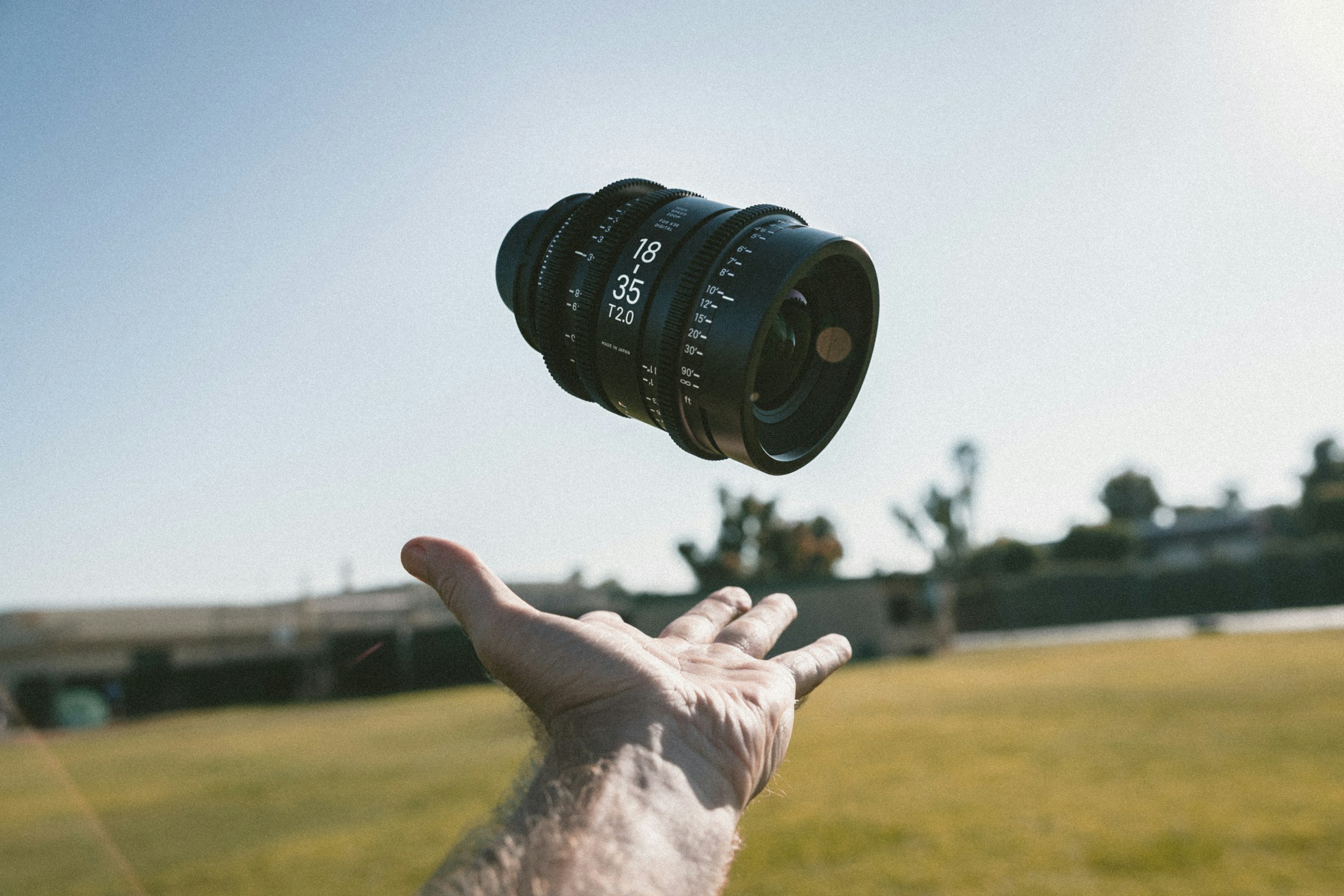Feb 6, 2025
How To Choose The Best Lens For Product Photography
Imagine you're shopping online for a new pair of running shoes. You land on a product page, and instead of compelling photographs showcasing the shoes from different angles, with detailed close-ups of the material and the sole, you see one or two blurry images with terrible lighting. You might not even make it to the product description — you’re already searching for a more reputable seller. This is the power of eCommerce photography: it can make or break a sale. The right lens can help you capture stunning product images that entice customers to hit that ‘buy’ button. In this blog, we’ll explore the best lens for product photography to help you achieve your goals.
As you read, remember that Caspa’s AI product photography platform can help you quickly capture beautiful, studio-quality product images. The software also creates automatic edits and zeroes in on the best eCommerce practices to ensure your photos have the best chance of converting shoppers into buyers.
Table of Contents
What to Look for When Choosing Lenses for Product Photography
Get AI Product Photos that Increase Your Sales for Free Today
8 Best Lens for Product Photography
1. Canon EF 24-70 f2.8: The Versatile Zoom Lens for Product Photography
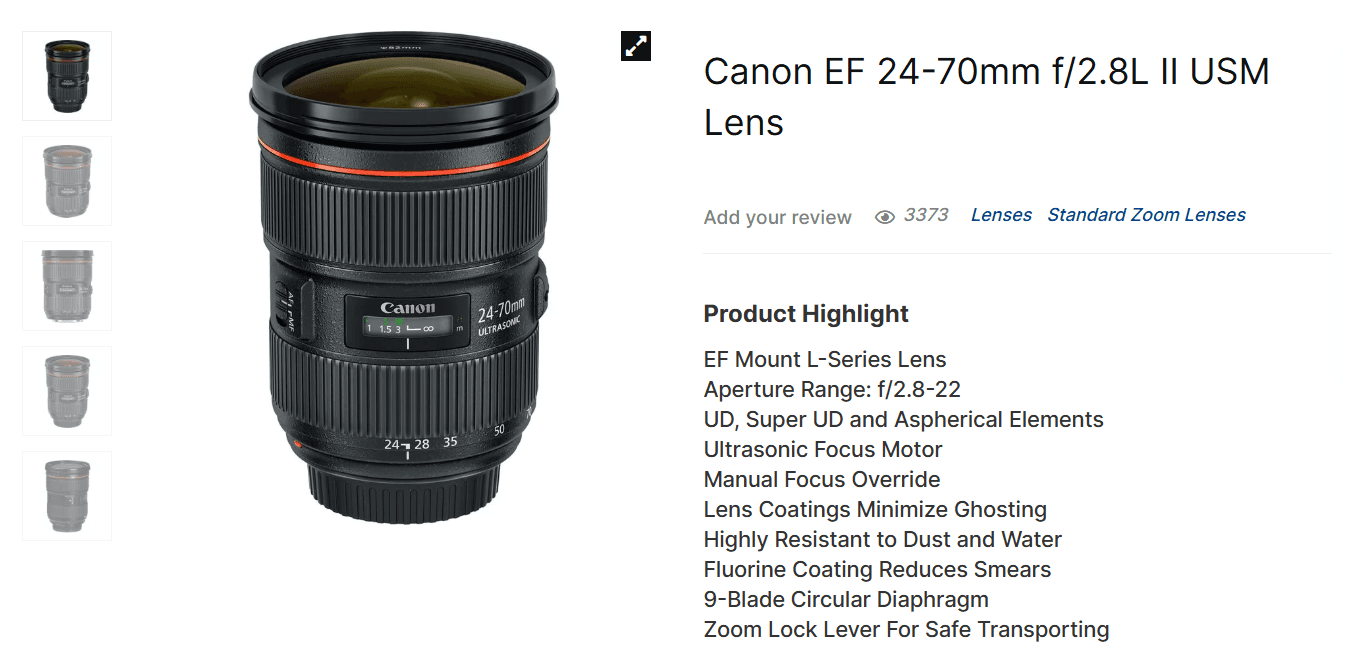
The Canon EF 24-70 f2.8 is a versatile zoom lens popular among product photographers using Canon cameras. It excels in eCommerce photography, offering wide-angle and portrait-length shots. This lens performs well in well-lit studios and environments with minimal lighting control (natural light).
Sharp & Versatile
Canon's sophisticated optical design includes one Super UD element and two UD elements to prevent color fringing and chromatic aberrations, ensuring clear and vibrant raw product photos. Its contrast and sharpness features are highly rated in online reviews. With an autofocus mechanism, it’s an excellent choice for novices, starting with a point-and-shoot camera and those exploring manual controls. Additionally, it’s durable enough for both indoor and outdoor use.
2. Sigma 24-105 f.4 Art: The High-Performance Zoom Lens
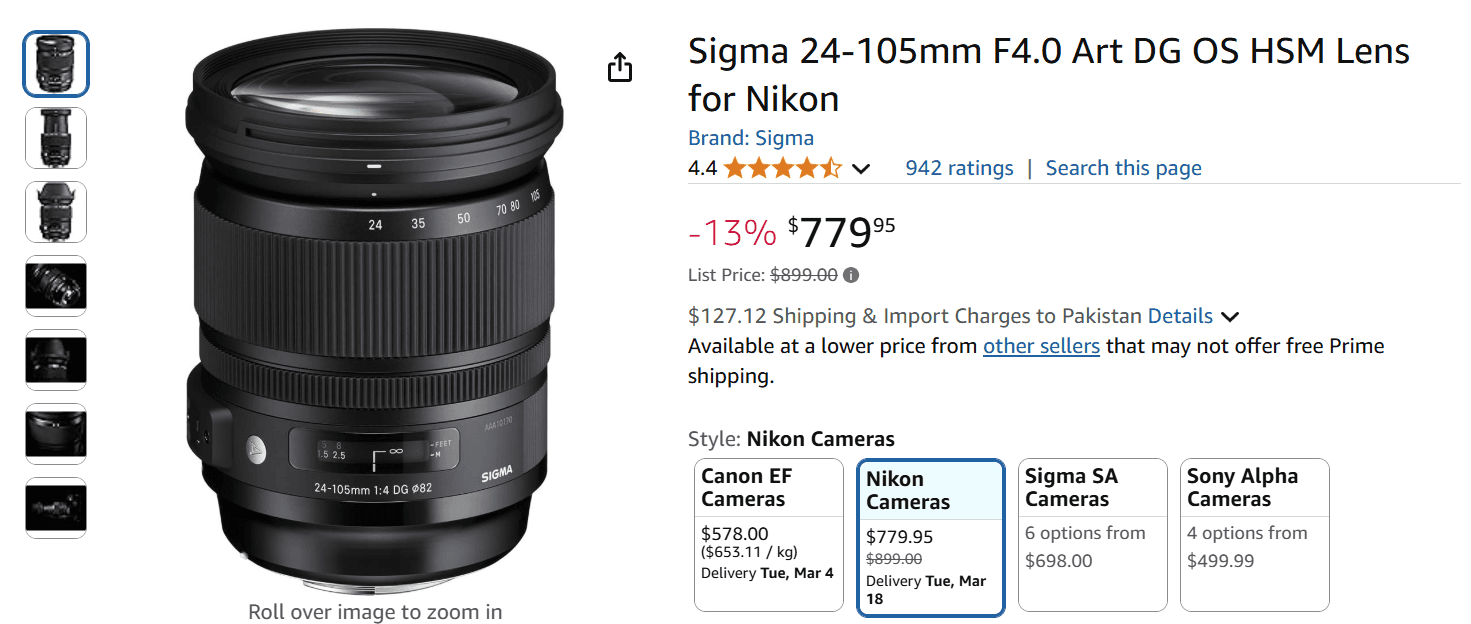
The Sigma 24-105 f.4 Art is an excellent zoom lens for capturing detailed and clear images that meet buyers' expectations. As SIGMA’s wide-angle, high-performance zoom lens, it delivers high resolution with the quality of a prime lens.
High-Resolution Zoom Lens
SIGMA promises the "full power of your camera’s image sensor," ensuring high-resolution images even while zooming. Its proprietary A1 MTF (modulation transfer function) is a standout feature, which allows for high megapixel resolution. This is ideal for creating crystal-clear images suitable for large prints. Even so, high-megapixel cameras can produce larger image files, which may require optimization for web design to prevent slow loading times that impact customer experience. While not a prime lens, the Sigma 24-105 f.4 Art offers powerful features, making it a strong contender for an entry-level product photography lens.
3. Nikon AF-S FX Nikkor 50mm f/1.8G Lens: The Compact Everyday Lens
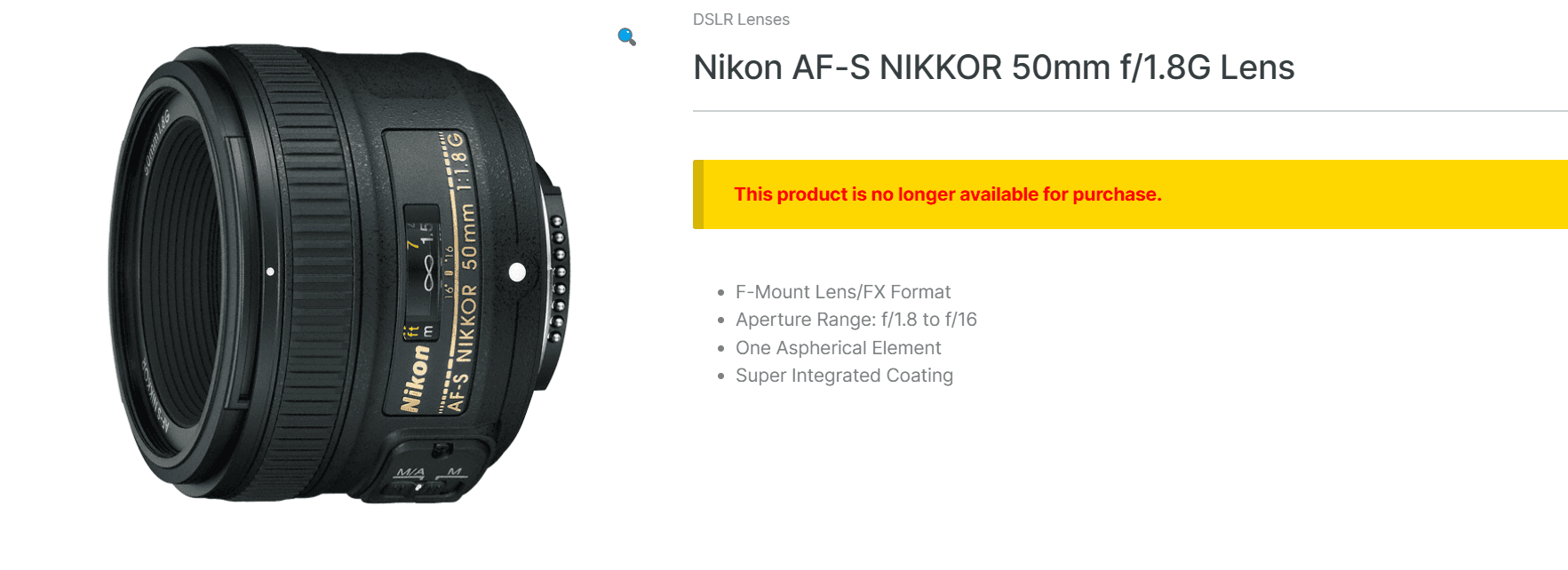
The Nikon AF-S FX Nikkor 50mm f/1.8G Lens is a compact and versatile option for eCommerce photography. Ideal for everyday use, it excels in basic product photography.
Sharp, Vibrant Product Photography Lens
With its fast aperture and Nikon’s professional-grade features, this lens delivers clear images that stand out from the background, even in less-than-optimal conditions. Its autofocus feature enhances sharpness, lighting, and color consistency, ensuring high-quality product shots. The 50mm focal length keeps the subject sharp and distinct from the background. In comparison, the AF-S NIKKOR 50mm f/1.8G’s Aspherical Lens Element preserves natural colors, preventing discoloration and maintaining vibrancy.
4. Macro Lenses: Sony FE 90mm f/2.8
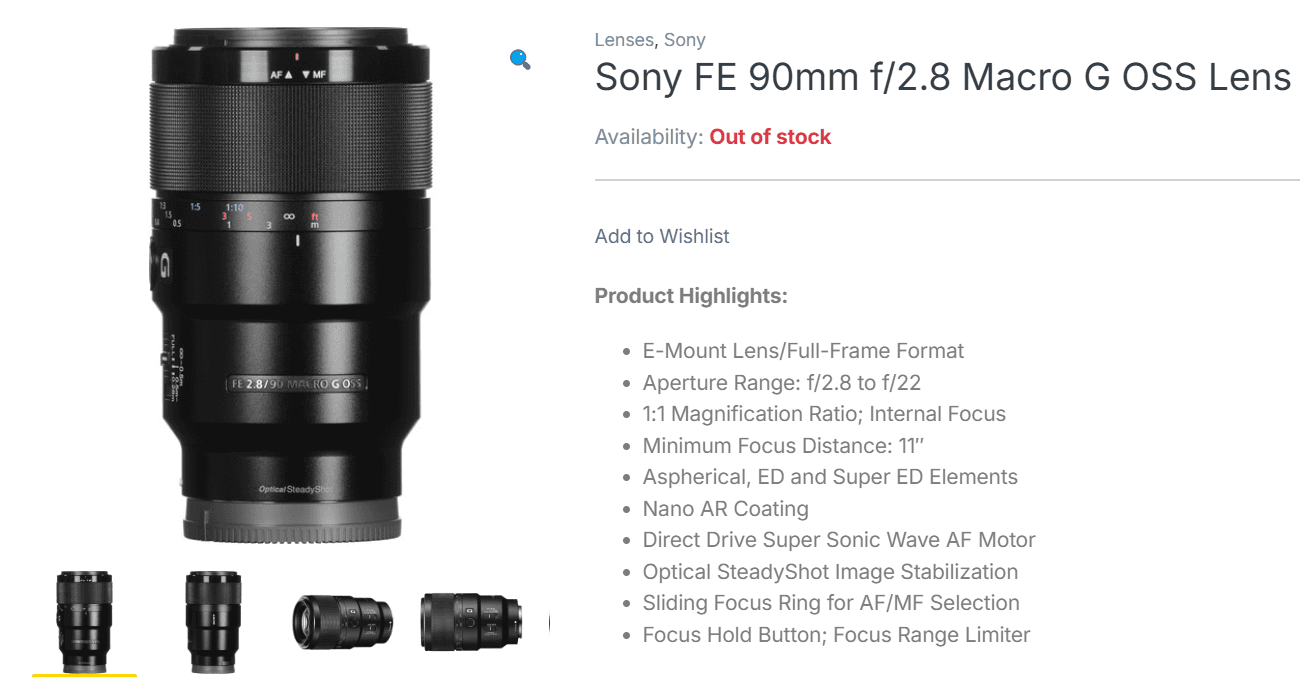
Macro lenses are not ideal for everyday product photography but are essential for specific products. The Sony FE 90mm f/2.8 is an actual macro lens, offering stunning resolution with up to 1:1 magnification. Designed for excellent optical performance, this lens can zoom in incredibly close without distorting the quality or focus of the subject. It also provides creative flexibility, allowing for unique, out-of-the-box shots. Additionally, the lens features built-in image stabilization, enabling you to explore different angles and capture stable images without relying heavily on a tripod.
5. Canon EF 100mm f/2.8L: The Sharp Macro Lens
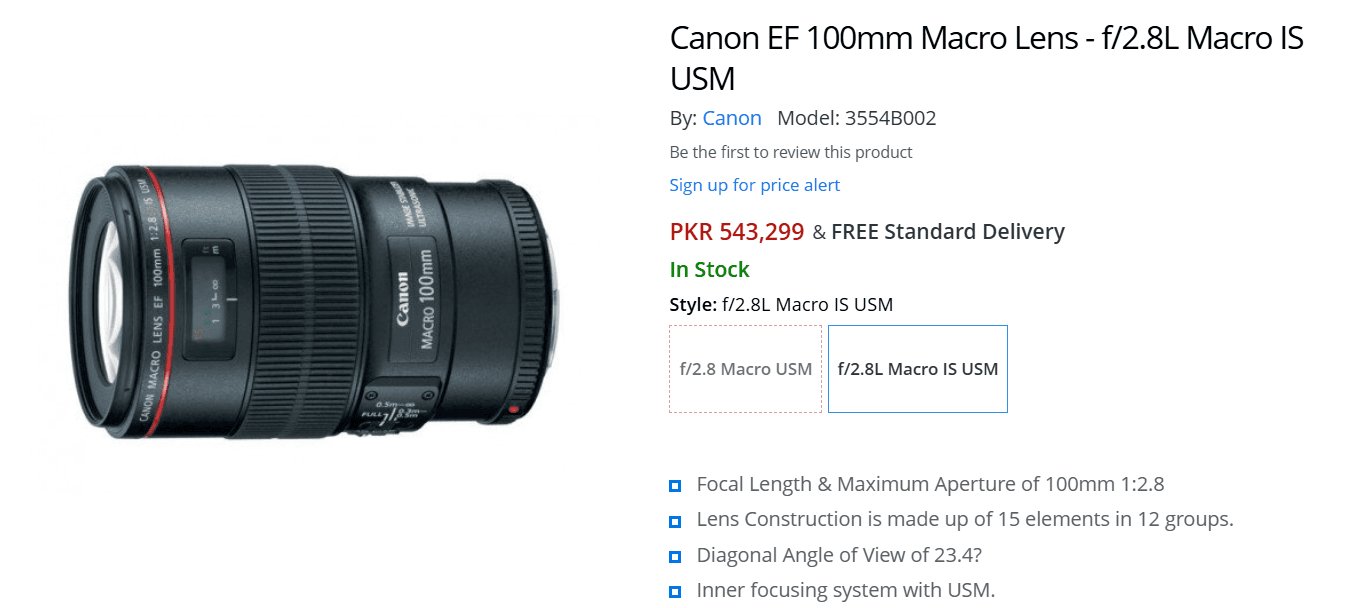
The Canon EF 100mm f/2.8L is a 1:1 macro lens with excellent image quality. It is one of Canon’s best lenses for sharp, clear product photography. Its superb image stabilization (IS) is a significant advantage, allowing you to capture high-quality photos even in low-light situations.
Sharp Macro and Portrait Lens
The lens offers manual focus fine-tuning to ensure precise focus, making it easy to get the perfect shot every time. The Canon EF 100mm f/2.8L is an outstanding choice for macro photography and doubles as a great portrait lens. It’s sharp, fast, and has a wide aperture, offering versatility for various occasions. Although it’s more expensive than other macro lenses, its image quality and features make it a worthwhile investment for serious photographers. Its macro capabilities are perfect for capturing intricate details of small products like jewelry or food.
6. Canon EF 50mm f/1.4: The Low Light Lens
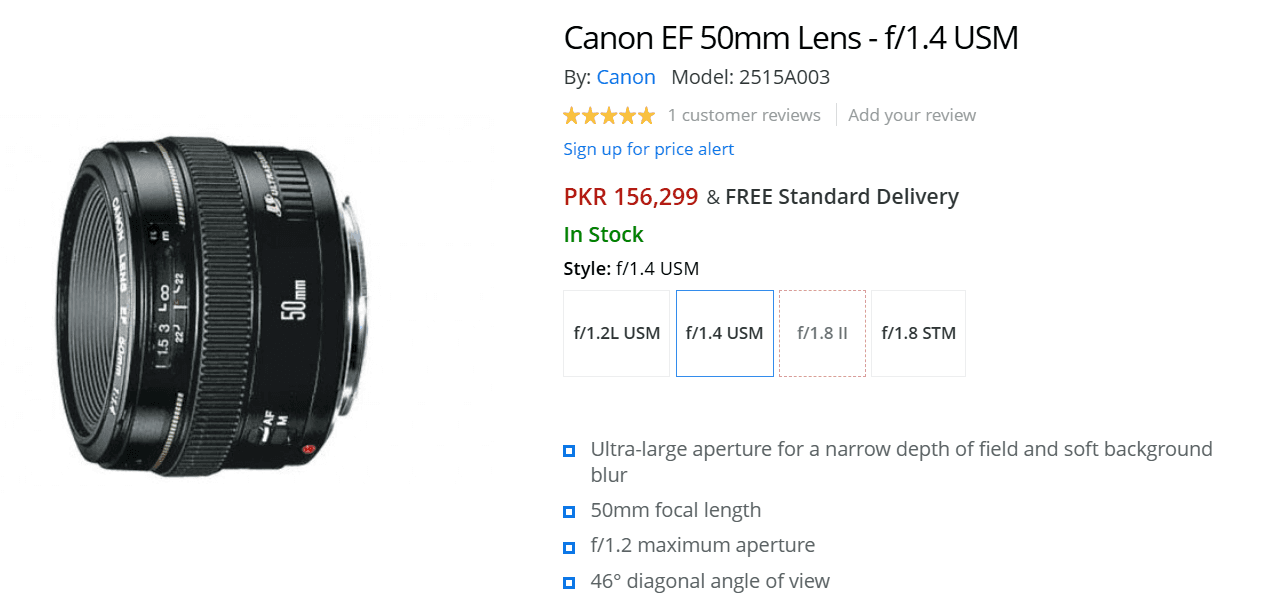
The Canon EF 50mm f/1.4 lens is ideal for shooting in low light on location, making it perfect for outdoor product photography using available light. You can shoot handheld, thanks to its fast aperture.
Affordable, Versatile Lens for Low Light
The 50mm focal length provides a natural feel to your subject, offering versatility across multiple photography genres, including:
Product photography
Portraits
Street photography
While the autofocus performance is generally good, some photographers have reported occasional hit-or-miss experiences. Overall, the Canon EF 50mm f/1.4 is a popular and affordable lens, though its feel and durability may not match that of higher-end models.
7. Sigma 105mm f/2.8 EX DG OS HSM Macro: The Budget-Friendly Macro Lens
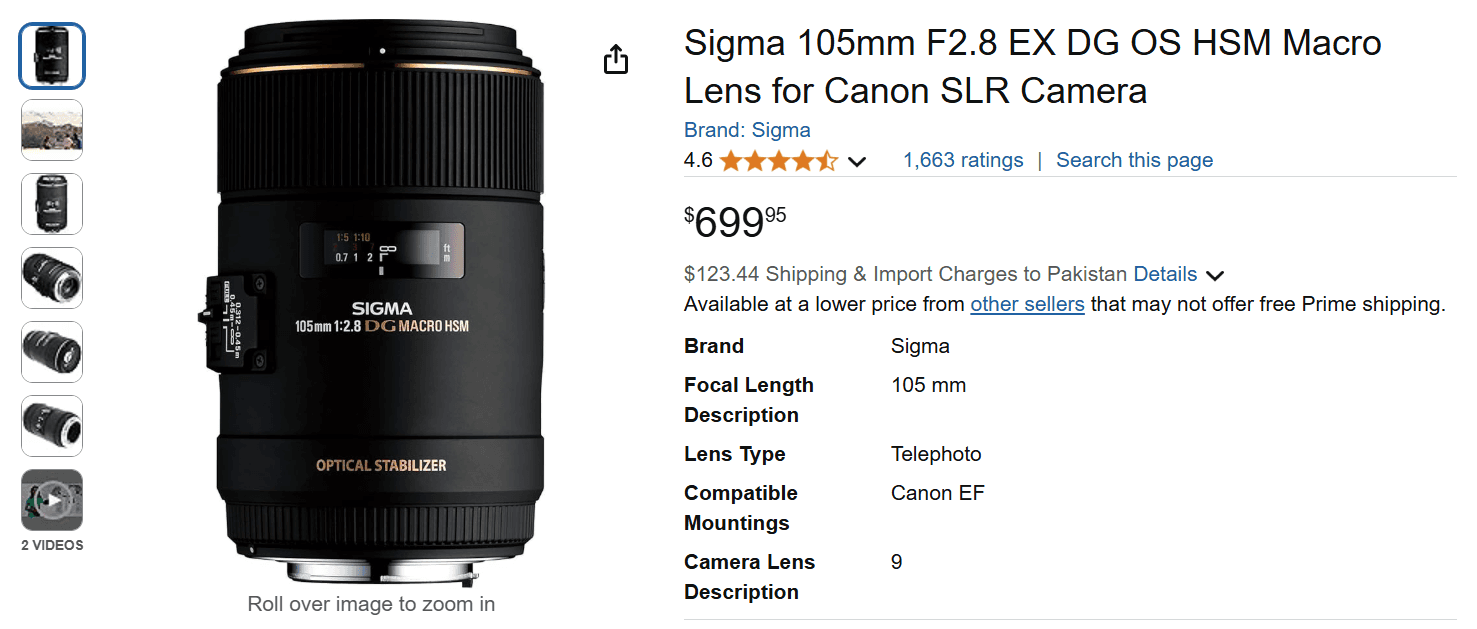
The Sigma 105mm f/2.8 EX DG OS HSM Macro is a professional-quality lens that's surprisingly affordable, typically priced in the mid-hundreds. While it's designed primarily for cameras with full-size sensors, it can also be used with compatible cropped sensors to achieve a broader practical focus.
Budget-Friendly Macro Lens with Stabilization
Its optical stabilizer system enhances performance for handheld photography, and the handheld photography performance reduces flare and ghosting. These features are especially useful in business environments where adjusting lights may not be easy, helping to capture clear, high-quality images. While it may not outperform some higher-end options, the Sigma 105mm f/2.8 is an excellent budget-friendly choice compatible with most full-frame digital cameras.
8. Canon TS-E 90mm f/2.8: The Alternative Lens
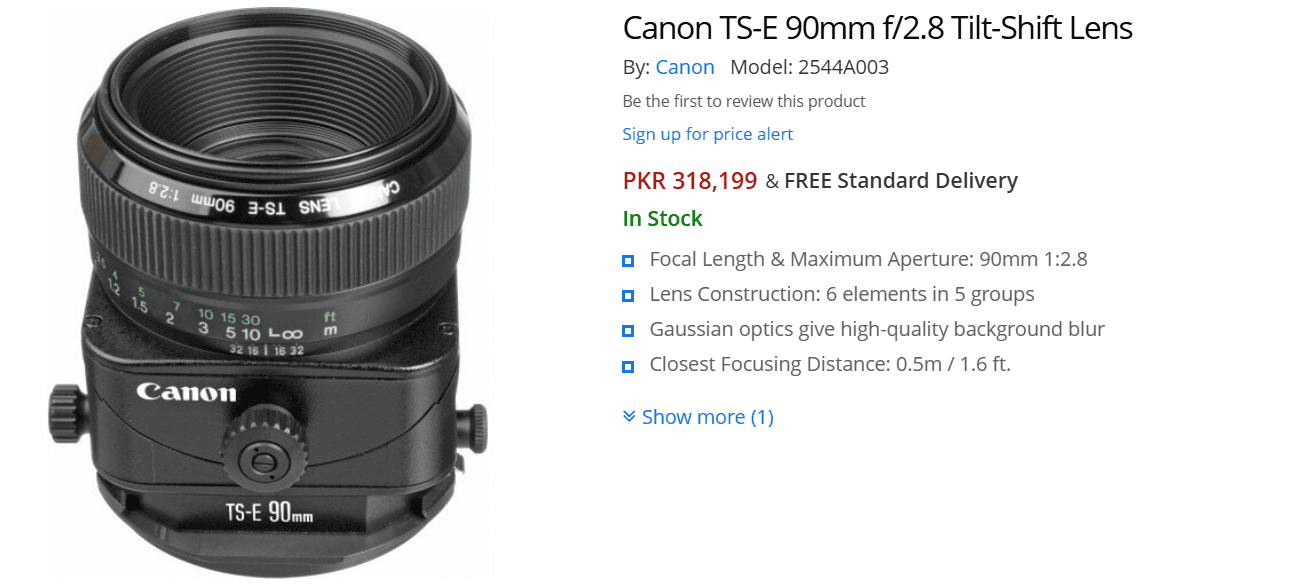
The Canon TS-E 90mm f/2.8 isn't quite as good as the previous options, but it’s also about half the price, and that makes a difference when you’re buying a professional-quality lens. The most notable thing about this lens is its focus, which offers a slightly compressed perspective but still creates well-corrected images.
Related Reading
• How to Take the Best Product Photos
• How to Edit Product Photos
• Midjourney Product Photography
• Ecommerce Product Photos
4 Types of Lenses for Product Photography
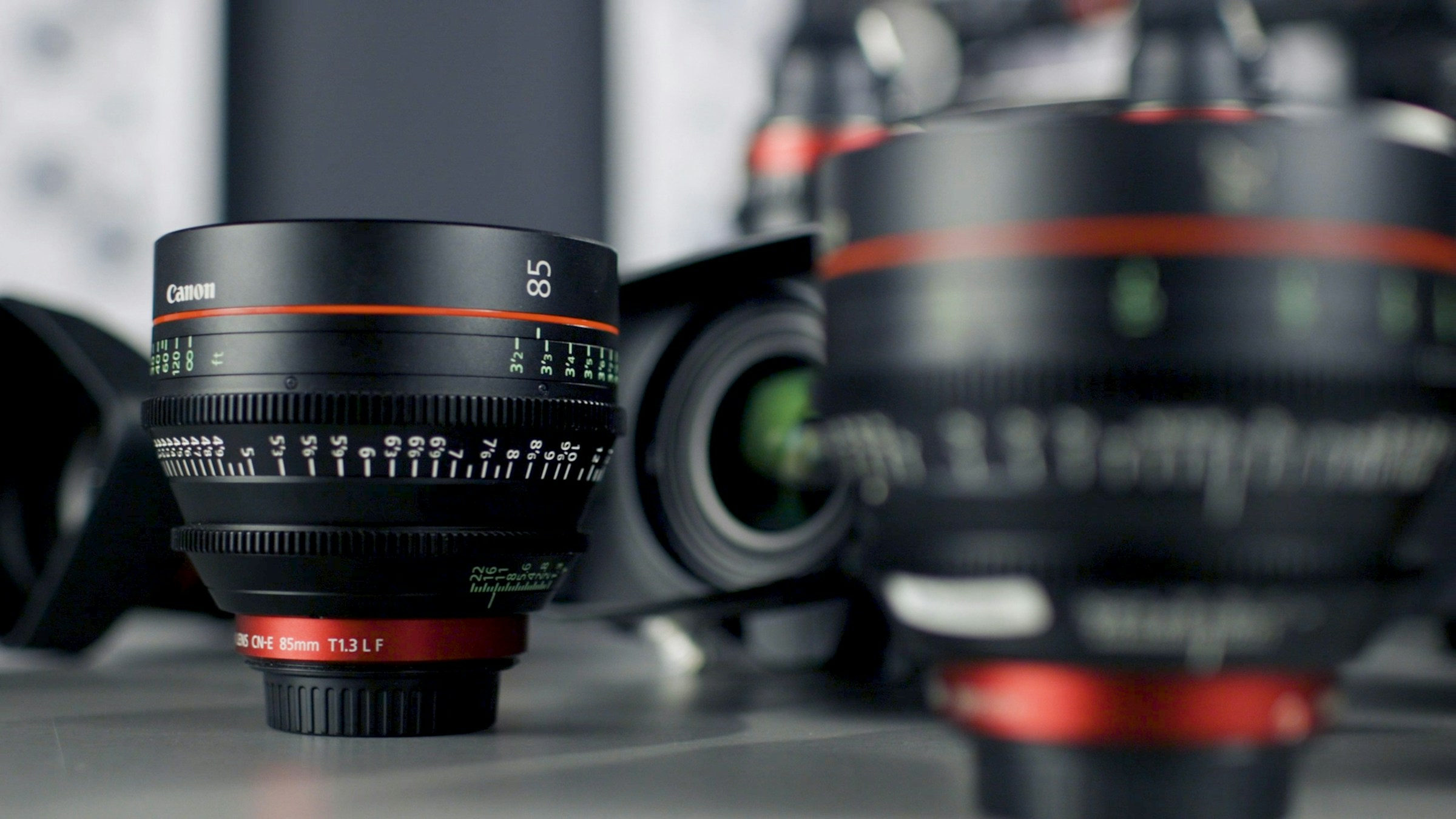
1. Discover the Magic of Macro Lenses for Product Photography
Macro lenses shine in product photography, especially when capturing the minor details of jewelry, watches, and other small items. They allow for extreme close-up shots, giving products a lifelike appearance that can help capture the attention of potential customers. They also create a shallow depth of field, which can help blur the background to make the product stand out even more.
2. Go Wide with Wide-Angle Lenses
Wide-angle lenses capture a wider field of view, making them an excellent option for photographing larger products like furniture or appliances. They allow you to fit more of the product in a single shot, which can help reduce the number of images needed to provide a complete visual representation of your product. Wide-angle lenses also offer a greater depth of field, which is helpful for product photography because it allows you to keep more of the image in focus.
3. Get Closer with Telephoto Lenses
Telephoto lenses are excellent for product photography when shooting from a distance. For example, suppose the product is large or located in a hard-to-reach area. In that case, a telephoto lens lets you capture images without disturbing the surrounding area or changing the product’s setting. Telephoto lenses also create a compressed look that makes the product appear much closer than it is.
4. Standard Lenses: The Versatile Option for Product Photography
Standard lenses have a focal length closely resembling the human eye, so they capture images with a natural perspective. This makes them a versatile option for product photography, as they can shoot various subjects, including large and small products. Standard lenses also have a balanced field depth, allowing you to take sharp, close-up images while retaining the background detail.
Caspa: AI-Powered Product Photography for eCommerce
Caspa helps eCommerce brands create stunning product photography with AI, eliminating the need for multiple tools, photographers, and models that traditionally eat up to 20% of revenue. From creating ultrarealistic product shots with human models to editing existing photos, Caspa's all-in-one AI product photography platform handles everything from background removal to upscaling, letting brands produce professional marketing visuals in seconds. Whether you need custom stock photos or complete studio editing capabilities, Caspa streamlines the entire product visualization workflow into a single, cost-effective solution.
Related Reading
• Types of Product Photography
• Product Photography Setup
• Product Photography Ideas
• DIY Product Photography Setup
• Lifestyle Product Photography
• Product Photography Examples
What to Look for When Choosing Lenses for Product Photography
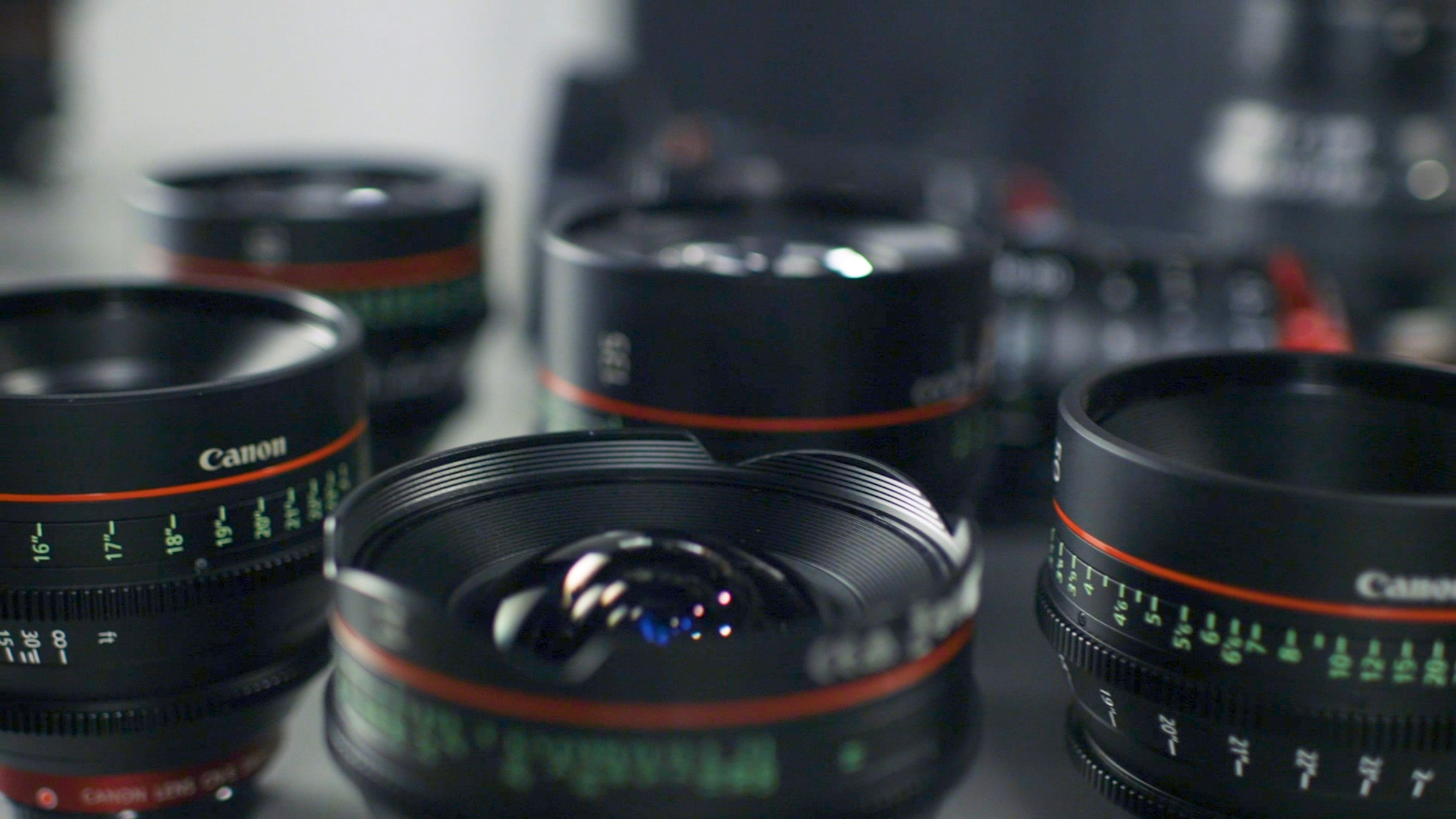
Focal Length: The Key to Product Photography Lenses
Focal length is the most significant factor when choosing a lens for product photography. The focal length affects the angle of view and how much of the scene is captured in the photograph. A short focal length (wide angle) lens will capture a wider scene, while a long focal length (telephoto) lens will capture a narrower scene. When photographing products, you want to use a lens with a focal length that will showcase them in the best possible way. If you’re photographing small objects, you’ll need a shorter focal length lens to show them in their entirety. If you photograph large objects, you may need a longer focal length lens to fit them into the frame.
Macro Lenses: Essential for Stunning Product Photography
Product photography often requires a high level of detail, and a macro lens is perfect for the job. By magnifying the subject, a macro lens allows the photographer to capture all the small details that make the product unique. In addition, a macro lens can provide a beautifully blurred background effect, making the product stand out even more. When used correctly, a macro lens can produce stunning results that showcase the product in its best light. For these reasons, macro lenses are essential for any professional product photographer.
Aperture: Blending Light and Depth of Field
Aperture is one of the three elements photographers use to control the exposure of an image. It is also critical in product photography, as it determines how much light enters the camera and hits the subject. Aperture also affects the depth of field or the area of an image that appears in focus. In product photography, a shallow depth of field is often used to create a sense of separation between the foreground and background. This can be especially effective when photographing small objects, as it helps to make them stand out from their surroundings.
Understanding Aperture and Depth of Field in Product Photography
By understanding how aperture affects exposure and depth of field, photographers can better control their product shots and create creative and eye-catching images. Even so, it’s also essential to consider the depth of field when choosing a lens for product photography. A considerable depth of field means that the foreground and background are in focus, while a small depth of field means that only the foreground is in focus and the background is blurred. You should use a small aperture to create a shallow depth of field and make your product stand out against the background.
Image Quality: Choose Your Lens Wisely
Image quality is one of the most important factors when choosing a camera lens for product photography. The lens is responsible for gathering light and focusing it onto the sensor. The quality of the resulting image depends on several factors, including:
Size of the aperture
Type of glass used
Coatings were applied to the lens
Lenses with larger apertures and higher-quality glass will produce sharper images with less distortion and better color rendition. Even so, these lenses can be more expensive, so it’s essential to consider your needs before purchasing.
Choosing the Right Lens for High-Quality Product Photography
If you aim to produce professional-quality images, it’s worth investing in a lens to help you achieve your goals. Image quality is another essential factor when choosing a lens for product photography. You want a lens that produces high-quality photos with accurate colors and minimal distortion. Some lenses produce better-quality images than others, so it’s worth researching before purchasing one.
Cost: Invest for the Best Product Photography Results
If you’re serious about product photography, you must invest in a high-quality lens. But how much should you spend? The answer depends on a few factors, including the type of camera you’re using and the products you’ll photograph. If you’re using a DSLR, you’ll need a lens with a large aperture to get crisp, clear shots even in low light conditions. You may also want a lens that can zoom in close to get detailed shots of small products.
Investing in a Quality Lens for Sharp and Vibrant Product Photos
On the other hand, if you’re using a point-and-shoot camera, you won’t need a lens of the same high quality. A mid-range lens should suffice. No matter what type of camera you’re using, it’s always worth spending a little extra on a quality lens. After all, the lens will ultimately determine the quality of your product photos. So, don't skimp on the lens if you want your photos to be sharp and vibrant. Invest in a quality piece of glass, and your product photos will be sure to dazzle. Lenses can range in price from around $100 to several thousand dollars, so choosing one that fits your budget is essential without sacrificing quality.
Why Your Choice Of Lens Matters in Product Photography
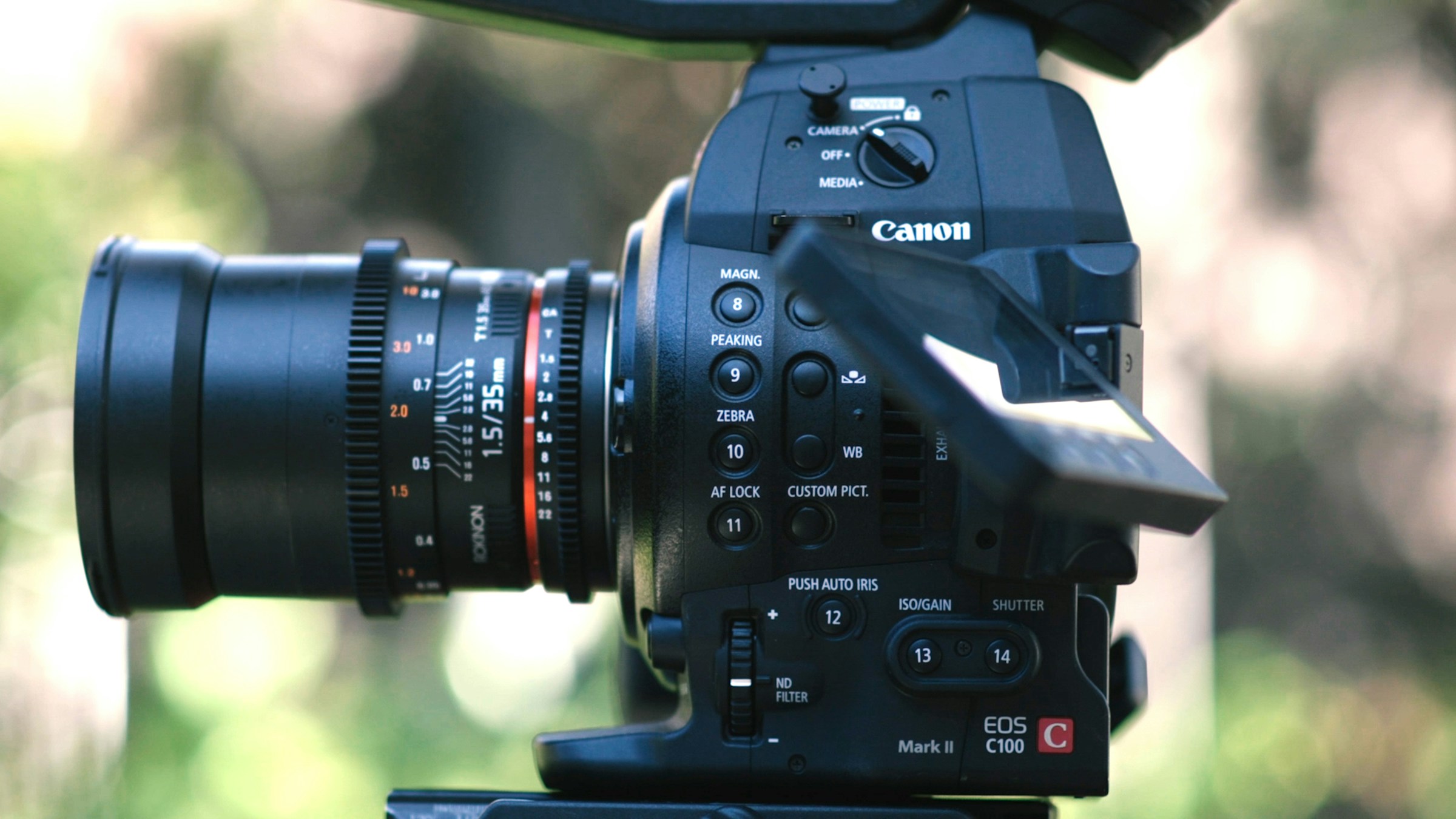
The choice of lens is critical in product photography. The right lens determines how well you can highlight your product's best features. It is essential because everyone wants detailed, high-quality images on eCommerce websites. The lens you use affects image sharpness, detail, and overall look. The right lens ensures that more information, such as texture, color, and design, is displayed accurately, creating visually appealing and professional images.
Choosing the Right Lens for Professional Product Photography
Any camera comes with a kit lens, and while it’s good if you are limited to bare photos, it’s undoubtedly not enough for professional purposes. If you want to work with a wide range of products, you need different types of lenses. Lenses vary in focal length and aperture, and in product photography, focal length is one of the crucial aspects to consider before shooting. For example, if you want a wide shot, you should use a lens with a lower focal length. An autofocus lens is your best choice for sharp, detailed photos.
Lenses Help Capture Product Details
The right lens helps show tiny details, such as:
Fabric texture of clothing
Capturing these details can significantly affect the product’s attractiveness to buyers.
Lenses with Wide Apertures Create Background Blur
A lens with a wide aperture (like f/1.8) allows you to create a blurred background effect. This technique makes the product pop out of the image, drawing more attention.
One Size Does Not Fit All: Different Products Need Different Lenses
No single lens is perfect for all products. Small items like rings need a macro lens to capture fine details, whereas more significant items like furniture need a lens with a lower focal length that offers more coverage.
Lenses Enhance Sharpness, Reducing Distortion
Sharpness is crucial in product photography to clearly show every part of the product. The right camera lens helps reduce distortion or blurring at the frame's edges and keeps the entire product sharp.
Get AI Product Photos that Increase Your Sales for Free Today

Artificial intelligence is changing how we approach every industry, and product photography is no exception. Caspa uses AI to help online brands create stunning product photos faster than ever. The best part? You don’t need any photography experience to use it. Caspa’s AI product photography tool creates ultra-realistic product images with human models that increase sales and lower return rates. You can also use the software to edit existing product photos, too.
AI Photos to Boost Sales
With Caspa, you get complete studio capabilities on one platform. There’s no need for costly models, photographers, and multiple editing tools that eat up to 20% of revenue. Instead, use Caspa to streamline your product visualization workflow into a single, cost-effective solution. Get started today to create AI product photos that increase your sales for free!
Related Reading
• Product Photography Pricing
• Use AI for Product Photography
• Product Photography Tools
• Soona Alternatives
• AI Product Image Generator
• AI Product Photography
• AI Product Photos
• AI Photoshoot
